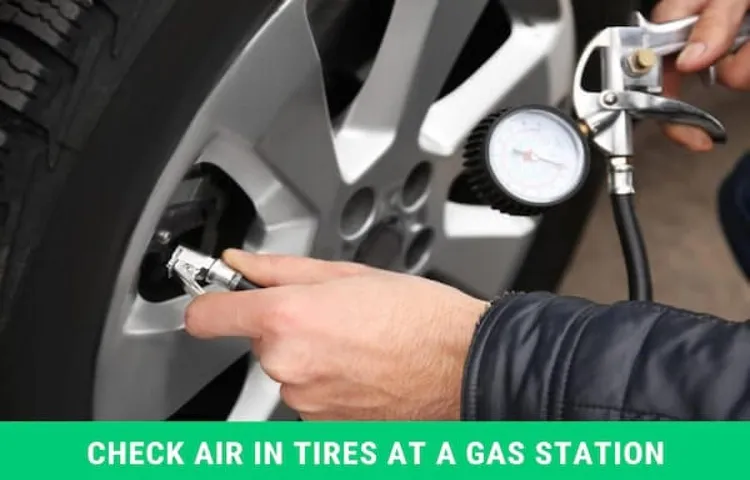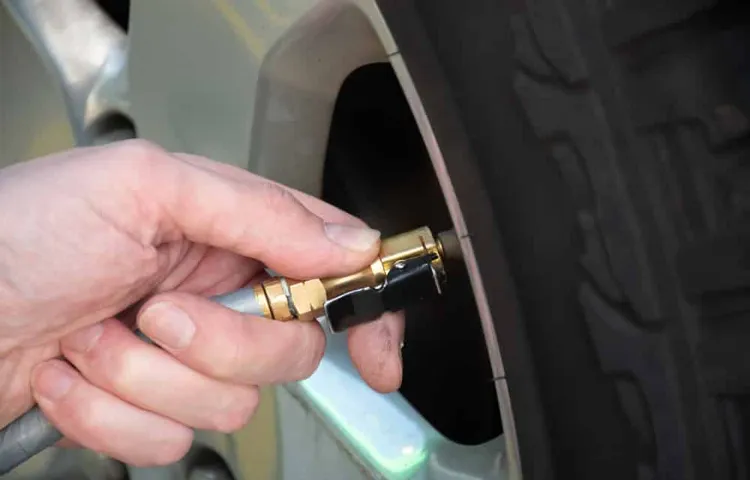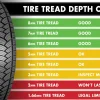Have you ever found yourself at a gas station, staring blankly at the air pump machine, unsure of how to remove air from your tires? It can be a frustrating experience, particularly if you’re already running late for an appointment or road trip. However, with a little bit of know-how, you can quickly and easily remove air from your tires at a gas station without feeling overwhelmed or confused. First things first, you need to locate the air pump machine at the gas station.
While it may seem obvious, some gas stations have more than one pump machine, so it’s important to make sure you have the right one. Once you’ve found the air pump machine, you’ll need to check the pressure in your tires to see if they need air or if you need to let some air out. If you need to let some air out, don’t worry, the process is simple.
Most air pump machines have a gauge that will read the pressure in your tire, so you can inflate or deflate them as needed. To remove air, simply press on the valve stem of your tire with a tool or your finger to release the air until you reach the desired pressure. It’s important to note that you should never try to remove air from a hot tire as this can cause damage to the tire.
It’s best to wait for the tires to cool down if they are hot from driving. Removing air from your tire at a gas station is a simple process, and it’s important to do it regularly to ensure your safety on the road. By following these steps, you can quickly and easily remove excess air from your tires to ensure a smooth and safe ride.
Table of Contents
Ensure Safety First
If you’re wondering how to take air out of tire at a gas station, safety should be your top priority. Start by putting your car in park and engaging the emergency brake, this is especially important if you’re parked on an incline. Then, locate the valve stem on the tire you want to deflate.
Remove the cap from the valve stem and press the tire gauge onto it firmly until you hear a hissing sound. The gauge should give you a reading of the air pressure, which will help you determine how much air needs to be released. To do this, press down on the valve stem until you hear the air escaping.
Keep an eye on the gauge and release air as necessary until you reach the desired pressure. Once you’re finished, don’t forget to replace the valve stem cap and check the pressure again using the gauge to ensure the tire is at the proper level. Remember, even though it may seem easy to release air from your car’s tires, it’s important to take these steps to avoid potential accidents or damage to your vehicle.
Check Tire Pressure First
When it comes to maintaining our vehicles, one of the most important things we need to prioritize is safety. After all, we rely on our cars to get us from point A to point B. One essential component of vehicle safety is tire pressure.
Regularly checking tire pressure might seem like a minor detail, but it can actually have a significant impact on the way your car performs and handles on the road. Low tire pressure can lead to poor gas mileage, decreased handling, and even blowouts. On the other hand, overinflated tires can also be dangerous, as they increase the risk of a blowout and reduce your car’s ability to grip the road.
To avoid all these risks, make sure you regularly check your tire pressure and ensure that your tires are properly inflated to the manufacturer’s specifications. By doing so, you’ll not only enhance your car’s performance but also protect yourself and your passengers on the road. Don’t forget to make this a regular part of your maintenance routine!

Park Your Car Safely
When it comes to parking your car, safety should always be the top priority. After all, you want to make sure your car is well-protected, while avoiding any potential hazards or accidents that could cause damage. One crucial step you can take to ensure safety is to always choose a safe and secure parking area.
Look for well-lit areas that are easily accessible, and if possible, park close to other parked cars or near security cameras. Additionally, be sure to use your car’s parking brake and put it in park before leaving it unattended. You never know when unexpected situations could arise, so it’s essential to take these simple precautions to protect your car and yourself.
Remember, safety first!
Using the Gas Station’s Air Pump
Taking air out of a tire at a gas station can be daunting, especially if you’ve never done it before. However, using the gas station’s air pump can actually make the job easier. First, you’ll need to locate the air pump, which is usually located by the gas station’s convenience store or garage.
Once you’ve found it, remove the cap from the tire’s valve stem, making sure not to lose it. Press the hose’s nozzle over the valve stem and check the air pressure on the gauge. To let air out, simply press the small metal plunger located on the nozzle’s side.
Repeat this process until the desired air pressure is reached. If you accidentally take out too much air, don’t worry; simply press the air pump’s “inflate” button and add more air until the pressure is right. Taking air out of your tires is vital to ensure safe driving and improve fuel efficiency, so don’t be afraid to use the gas station’s air pump and get the job done.
Identify the Air Pump’s Features
When using a gas station’s air pump, there are certain features that you should be aware of. These features can vary from machine to machine, but there are some common ones that you can expect to find. One of the most important features is the pressure gauge.
This will allow you to see the current pressure of your tires and ensure that you are not over or under inflating them. Additionally, most air pumps will have a hose and nozzle that you can attach to your tire valve. Some pumps may also have a built-in flashlight, making it easier to inflate your tires in the dark.
Another useful feature is an automatic shut-off valve, which will turn off the pump when your tire reaches the desired pressure. This not only ensures that you don’t overinflate your tires, but also saves you time and effort. By familiarizing yourself with these features, you can ensure a smooth and hassle-free tire inflation experience.
Remove the Valve Cap from Your Tire
When using a gas station’s air pump to inflate your tires, it’s essential to first remove the valve cap. This small plastic or metal cap protects the valve stem from debris, moisture, and damage. While it may seem like a small detail, overlooking this step can make it difficult or impossible to connect the air pump to the valve stem.
Remember to unscrew the cap by turning it counterclockwise, being careful not to let it fall onto the ground where it can easily get lost. Once the cap is removed, attach the air hose firmly onto the valve stem to begin inflating your tire to the recommended pressure level. By properly preparing your tire for inflation, you can save yourself time and potential frustration in the long run.
So, don’t forget to remove that valve cap before heading to the gas station.
Attach the Air Hose to the Tire Valve Stem
When pumping air into your tires at a gas station, it’s important to attach the air hose to the tire valve stem properly. First, make sure the air pump is turned on and the tire pressure gauge is set to the correct psi for your vehicle’s tires. Next, remove the cap from the valve stem and press the nozzle of the air hose onto the stem.
You should hear a hissing sound as air flows into the tire. Make sure to hold the nozzle firmly in place to prevent any air leaks. As the tire inflates, use the pressure gauge to monitor the psi and stop when you reach the recommended level.
Finally, remove the nozzle and replace the valve stem cap. Remember to always check your tire pressure regularly to ensure safe driving conditions.
Press the Lever to Add Air to the Tire
When it comes to keeping your tires properly inflated, it’s important to have access to an air pump, especially at gas stations. Using the gas station’s air pump is simple and straightforward. First, locate the air pump, usually found near the gas station’s convenience store or gas pumps.
Then, remove the valve cap from your tire and attach the pump nozzle. Press the lever on the air pump to add air to the tire, and periodically check the pressure with a tire pressure gauge. It’s important to not overinflate your tires, as this can cause them to wear out faster and affect your vehicle’s handling.
By regularly checking and maintaining the correct tire pressure, you can improve your vehicle’s fuel efficiency, tire lifespan, and overall safety. So next time you fill up at the gas station, don’t forget to press the lever and add air to your tires.
Press the Lever to Release Air from the Tire
If you’re unfamiliar with using the gas station’s air pump, it can seem intimidating. However, it’s a necessary skill to have if you want to properly maintain your vehicle’s tires. First, locate the air pump and make sure it’s working by pressing the button.
Once you’ve confirmed it’s working, remove the valve cap from the tire you want to inflate. Then, press the nozzle of the air pump onto the valve stem and listen for the sound of the tire filling up with air. It’s important to check the tire’s pressure before and during inflating; you don’t want to risk overinflating the tire and causing damage.
If the tire is overinflated, use the lever on the nozzle to release air until you’ve reached the proper pressure. Remember, maintaining your tire pressure can improve your vehicle’s fuel efficiency and overall performance. So, next time you use the gas station’s air pump, don’t be intimidated – just take it step by step.
Checking the Tire Pressure Again
When it comes to checking the tire pressure of your car, it’s a simple enough task that anyone can do it. And if you’re ever at a gas station and need to take air out of your tire, it’s just as easy. First, you’ll need to locate the air pump machine.
Most gas stations will have one, and they’re usually free to use. Once you’ve found the machine, you’ll need to take the cap off of the tire valve stem. You can then attach the air hose to the valve stem, making sure it’s nice and snug.
From there, you can turn on the air pump and wait until the pressure gauge reaches your desired amount. But what if you’ve accidentally overinflated your tire? Don’t worry, it’s not the end of the world. To take air out of your tire, you’ll just need to press the valve stem down with a screwdriver or the edge of your keys.
This will release some of the air until you reach your desired pressure. And voila, you’re done! Remember, it’s important to check your tire pressure regularly to ensure your car is operating safely. Overinflated or underinflated tires can both be dangerous, so it’s best to make this task a routine part of your car maintenance.
By taking care of your tires, you’ll be ensuring your safety on the road.
Re-check the Tire Pressure with a Gauge
“tire pressure gauge” Once you have filled your tires with the proper amount of air, it’s essential to use a tire pressure gauge to check the pressure. Even though you filled the tires to the recommended psi, it’s essential to ensure that they are still at that pressure after a few days or weeks of driving. Over time, the tires can lose pressure, which can lead to under-inflation and increased fuel consumption.
Using a tire pressure gauge to check the pressure is simple and easy; insert the gauge’s nozzle onto the valve stem and press down to get a reading. If the pressure is low, you can top it up with air until it reaches the recommended psi level. Remember, over-inflating your tires can also be harmful, leading to a bumpy ride and possibly even a tire blowout.
That’s why using a tire pressure gauge is crucial. By using a tire pressure gauge regularly, you’ll save money on fuel and reduce the chance of experiencing a flat tire on the road. So, invest in a tire pressure gauge and use it every time you check your tire pressure.
Wrap-Up and Final Thoughts
Taking the air out of a tire at a gas station can be a bit confusing, especially if it’s your first time doing it. But don’t worry, it’s actually quite simple. First, you need to locate the air pump at the gas station, which is usually located near the gas pumps.
Next, unscrew the valve cap on your tire and press the air gauge onto the valve stem to release air and check the tire pressure. If the tire pressure is too high, use the air pump to let out some air. It’s important to do this gradually and check the tire pressure frequently to avoid over-deflating your tire.
Keep in mind, if you deflate your tire too much, you’ll need to add air back in to get it to the correct pressure. Overall, taking the air out of a tire at a gas station is a quick and easy process as long as you take your time and pay attention to the tire pressure.
Conclusion
In conclusion, taking the air out of a tire at a gas station is a breeze. With a few simple steps and the right tools, you can quickly and efficiently deflate your tires. Just remember to check your pressure regularly and don’t let it get too low, or you’ll be feeling deflated yourself.
So go forth and take control of your tire pressure like the true air expert you are!”
FAQs
Can I use the air pump at a gas station to remove air from my tire?
Yes, most gas station air pumps have a deflate feature that allows you to let air out of your tire.
What is the correct air pressure for my tires?
The recommended air pressure for your tires can usually be found on a sticker inside the driver’s side door or in your vehicle’s owner’s manual.
How do I know if my tire is underinflated?
If your tire is underinflated, it may appear visibly flat or you may notice poor handling, poor fuel economy, or increased tire wear.
Can I deflate my tire too much?
Yes, deflating your tire too much can cause damage to the tire and rim, and may require expensive repairs.
How long should it take to remove air from my tire?
This will depend on how much air needs to be removed from the tire, but it should only take a few minutes to fully deflate a tire.
Can I use an automatic air pump to remove air from my tire?
Yes, most automatic air pumps have a deflate feature that allows you to let air out of your tire.
Should I remove air from all four tires or just the one that is underinflated?
It is recommended to have all four tires at the correct air pressure, but you only need to remove air from the one that is underinflated.



